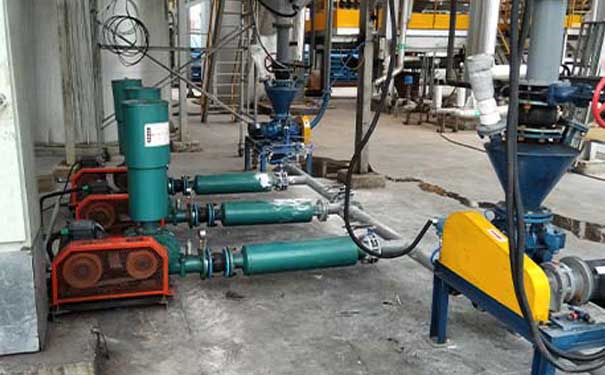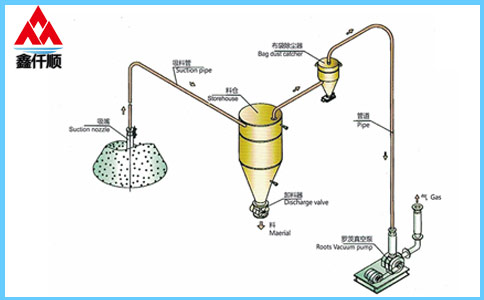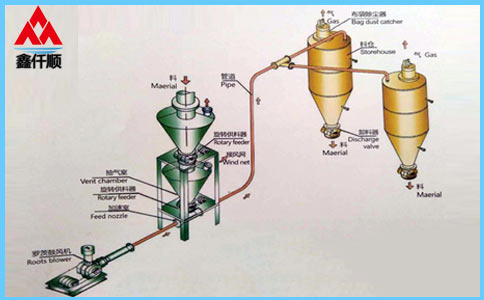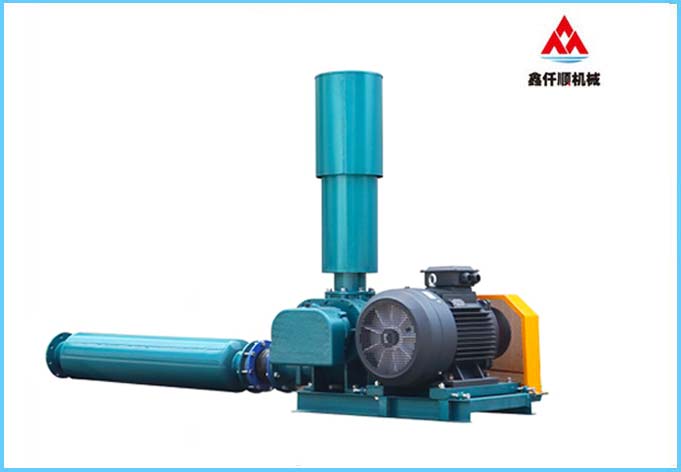People who believe in dry water treatment should not be unfamiliar with Roots blower, which is a kind of positive displacement compressor and belongs to rotary machinery.
Roots blower is very easy to be affected by the surrounding environment in the real working environment, thus causing failure. Therefore, it is very important to analyze and handle the faults of Roots blower,
Therefore, after consulting countless materials and communicating with dozens of water friends, I summarized the common fault causes and solutions of Roots blower.
1. Working principle of Roots blower
Roots blower is a kind of volumetric rotary gas power machine, which has two waist shaped involute rotors. The two rotors are rotated in opposite directions at the same speed through the driving and driven shaft gears to complete the suction and exhaust process.

When the left rotor rotates clockwise, the right rotor rotates counterclockwise, the gas is sucked in from the inlet, moves with the working chamber formed during rotation, and finally is discharged from the upper outlet.
Between the two rotors, between the two rotors and the casing and the side cover plate, it is necessary to ensure that there is no collision with each other and that the efficiency is not affected by excessive clearance. During the operation of the two rotors, a small gap is always maintained so that the exhaust gas does not return to the intake chamber as far as possible.
Its characteristic is that the output air volume is proportional to the number of revolutions. When the outlet pressure of the fan changes, the delivered air volume does not change significantly. Roots blower itself cannot compress gas, and the pressure rise depends on the back pressure of the working system at the exhaust port.
2. Roots blower fault
After several maintenance summaries and exchanges with Shuiyou, the main causes of unit failures include shaft breakage, bearing damage, large unit vibration, rotor seizure, shaft seal leakage, etc. The main causes of increased maintenance frequency are rotor seizure and friction.
3. Cause analysis of Roots blower fault
Friction between rotor and shell or between rotors is a common fault of Roots blower. If this fault occurs during operation, it will be accompanied by serious vibration and noise. After the Roots blower has been shut down for a long time, the rotor is often jammed. Here, the main causes of the fault are summarized as follows.
Inappropriate clearance between rotor blades and hinges
The clearance between rotor blades and hinges is inappropriate, and the clearance between rotor blades and hinges changes during operation. The two rotors will collide when rotating at low speed, resulting in friction or even jamming between rotors.
If this fault occurs during operation, it will cause collision between the two rotors or between the rotor and the housing, resulting in a strong impact sound; The vibration becomes larger, which can even cause foundation vibration; At the same time, the temperature of the friction part rises rapidly, and even the case is hot and red.
Bearing damage
Poor operating conditions of the fan, oil seal damage, excessive assembly clearance, etc. will lead to bearing damage, while bearing damage will cause temperature rise, bearing block temperature will also increase, and in serious cases, bearing block will be deformed.
In particular, when the inner and outer rings of the bearing are locked, the bearing block and the side cover plate will be subject to large external forces, and the temperature will also be very high. The bearing block and the side cover plate will be heated unevenly, which will cause deformation and cracks of the side cover plate in serious cases.
The wear of shaft diameter leads to excessive clearance between the shaft and the bearing inner ring, and the wear of bearing seat leads to excessive clearance between the bearing seat and the bearing outer ring, which will cause the rotor to jam or friction. Especially for the fan connected with the belt, the driving shaft is pulled by the belt, resulting in a large one-way force on the bearing seat, which is prone to unilateral wear of the bearing seat of the driving shaft at the belt side.
Gear wear
Gear wear and increase of gear side clearance will change the position of the two rotors, reduce the gap between the active rotor and the driven rotor and increase the gap between the blades, causing collision and friction between the two rotors.
Rotor or housing deformation
If the rotor or housing is deformed, the clearance between the outer diameter of the rotor and the housing will be too small, resulting in friction and jamming of the rotor.
Small clearance between rotor end face and side cover plate
If the clearance between the rotor and the side cover plate is too small, there are sundries squeezed between the rotor and the side cover plate; Or after the axial positioning bearing is worn, the axial displacement of the rotor becomes larger, which will cause friction between the rotor and the side cover plate, causing the rotor to jam.
4. Troubleshooting of Roots blower
Adjust the clearance of the split leaf
Use a feeler gauge to check the clearance value of rotor split and hinge blades to make it within the standard range. Check the back cap and bolt for clearance adjustment to ensure their integrity.
Requirements: the blade clearance accounts for 1/3 of the total clearance, but not less than 0.15 mm; The hinge clearance accounts for 2/3 of the total clearance and is 1.5 times larger than the gear side clearance.
The hinge means that the meshing face of the active rotor tends to approach the passive rotor; The split blade means that the meshing face of the active rotor tends to be far away from the passive rotor. If the clearance between the rotor opening and closing blades is not appropriate, the relative circumferential angle between the gear sleeve and the hub or between the gear and the shaft can be adjusted.
The adjustment of rotor blades and hinges is the key part of Roots blower maintenance, which directly determines the quality of maintenance. Different types of Roots blowers have different adjustment forms. When the shaft and the gear are connected in a tapered keyless manner, the relative position of the shaft and the gear in the circumferential direction is generally adjusted; When the shaft is connected with the gear by a key, the relative position between the driven gear and the hub is generally adjusted.
During the normal operation of the fan, the clearance will change with the wear of the gear, in which the clearance of the hinge tends to decrease and the clearance of the splitter tends to increase. When adjusting the working clearance of the two impellers, the clearance of the hinge should be properly increased in advance. Generally, the clearance of the hinge is twice that of the splitter.
When adjusting the impeller clearance, first turn the blade to a position that is 45 ° from the horizontal direction. At this time, the clearance between the two impellers is the clearance between the splitter and the hinge.
During field adjustment, generally use a feeler gauge of the same thickness to fix between the two rotors, fix the two rotors, and then install the driving gear. Align the mark of the driven gear with the mark of the driving gear and press it onto the shaft. Install the gear retainer ring, stop washer and fastening nut in turn. After adjustment, use a feeler gauge to measure the actual size of the clearance between the splitter and the hinge. If it is not suitable, readjust it until it meets the standard.
Replace bearing
Check whether the side cover plate is deformed or cracked. The deformation is not serious, and the high points can be polished; Replace the side cover plate in case of serious deformation; If there are cracks, repair welding can be carried out.
Check whether the bearing seat and shaft diameter are worn. If the shaft is worn, repair welding is generally carried out; If the bearing pedestal is worn, the individual bearing pedestal is usually replaced with a new one without repair; When the bearing pedestal is integrated with the side cover plate, the bearing pedestal shall be welded again to make its fit clearance meet the technical requirements.
Check the backlash and replace the gear
Check the contact area of the gear engagement part with red lead powder. The methods for checking the backlash on the tooth side include the marking method, the feeler gauge method, and the lead wire pressing method.
Standard requirements: the backlash is 0.10~0.18mm, the meshing part is in the middle of the tooth surface, the contact area of the tooth surface is not less than 50% along the tooth height direction, and not less than 70% along the tooth width direction. If the test result does not meet the requirements, the gear shall be replaced.
Use a feeler gauge to measure the clearance between the rotor and the housing
The standard range of clearance between rotor and housing is 0.3~0.6 mm. During on-site maintenance, the clearance of 6 points is generally measured, and the up and down and horizontal directions of each rotor are as shown in the figure.
Grinding treatment can be carried out for small deformation; In case of large deformation or crack between rotor and housing, it shall be scrapped in time.
Clean rotor end face and side cover plate
Check the axial clearance between the rotor end face and the casing with a feeler gauge. The clearance of locating end (gear side) d=0.1~0.2 mm, the clearance of non locating end (pulley side) c=0.3~0.5 mm, and the standard of total clearance is 0.4~0.7 mm.
Different types of Roots blowers have different end clearances under different working conditions, which shall be adjusted according to their own maintenance standards during on-site maintenance. If the unilateral clearance is not appropriate, it can be adjusted by adding or subtracting bearing adjusting shims; If the total clearance is not appropriate, it can be adjusted by adding or subtracting the adjusting shim on the joint surface of the side cover plate, but the shim thickness generally does not exceed 1mm. Measure the axial displacement of the rotor with the shaft pushing method. The displacement standard is 0.05~0.10mm. If it exceeds 1.5 times the standard maximum value, replace the bearing.
5. Write at the end
Roots blower has many advantages. Although magnetic suspension blower and air suspension blower are gradually emerging, their application in water treatment industry is still the mainstream.
Through summary, we can see that the faults of fans are caused by multiple complex reasons. However, as long as the maintenance personnel can confirm each maintenance data in strict accordance with the inspection and maintenance procedures, judge whether it meets the maintenance standards and avoid repeated maintenance, the time for troubleshooting can be greatly shortened to ensure safe, stable and long-term operation of the equipment. The above is about the causes of Roots blower failure in sewage treatment. I hope it can help you. If you have any questions, please consult:
0531-83663588










